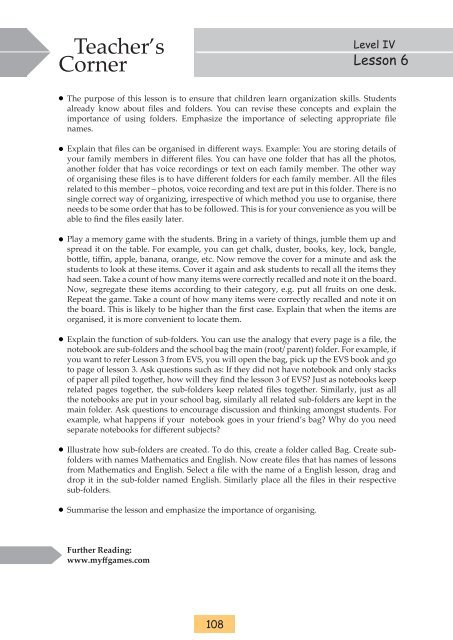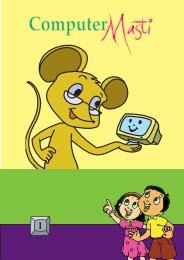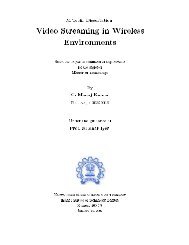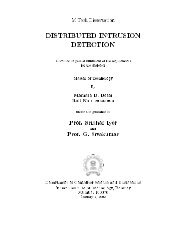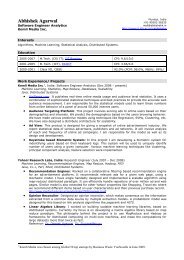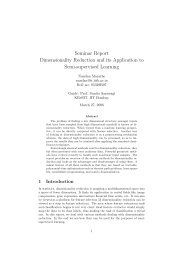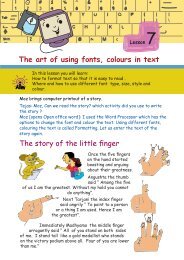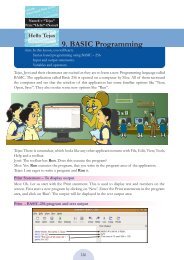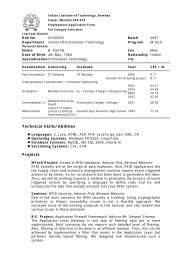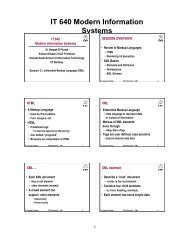worksheets - Indian Institute of Technology, Bombay
worksheets - Indian Institute of Technology, Bombay
worksheets - Indian Institute of Technology, Bombay
You also want an ePaper? Increase the reach of your titles
YUMPU automatically turns print PDFs into web optimized ePapers that Google loves.
Teacher’s<br />
Corner<br />
Level IV<br />
Lesson 6<br />
The purpose <strong>of</strong> this lesson is to ensure that children learn organization skills. Students<br />
already know about files and folders. You can revise these concepts and explain the<br />
importance <strong>of</strong> using folders. Emphasize the importance <strong>of</strong> selecting appropriate file<br />
names.<br />
Explain that files can be organised in different ways. Example: You are storing details <strong>of</strong><br />
your family members in different files. You can have one folder that has all the photos,<br />
another folder that has voice recordings or text on each family member. The other way<br />
<strong>of</strong> organising these files is to have different folders for each family member. All the files<br />
related to this member – photos, voice recording and text are put in this folder. There is no<br />
single correct way <strong>of</strong> organizing, irrespective <strong>of</strong> which method you use to organise, there<br />
needs to be some order that has to be followed. This is for your convenience as you will be<br />
able to find the files easily later.<br />
Play a memory game with the students. Bring in a variety <strong>of</strong> things, jumble them up and<br />
spread it on the table. For example, you can get chalk, duster, books, key, lock, bangle,<br />
bottle, tiffin, apple, banana, orange, etc. Now remove the cover for a minute and ask the<br />
students to look at these items. Cover it again and ask students to recall all the items they<br />
had seen. Take a count <strong>of</strong> how many items were correctly recalled and note it on the board.<br />
Now, segregate these items according to their category, e.g. put all fruits on one desk.<br />
Repeat the game. Take a count <strong>of</strong> how many items were correctly recalled and note it on<br />
the board. This is likely to be higher than the first case. Explain that when the items are<br />
organised, it is more convenient to locate them.<br />
Explain the function <strong>of</strong> sub-folders. You can use the analogy that every page is a file, the<br />
notebook are sub-folders and the school bag the main (root/ parent) folder. For example, if<br />
you want to refer Lesson 3 from EVS, you will open the bag, pick up the EVS book and go<br />
to page <strong>of</strong> lesson 3. Ask questions such as: If they did not have notebook and only stacks<br />
<strong>of</strong> paper all piled together, how will they find the lesson 3 <strong>of</strong> EVS? Just as notebooks keep<br />
related pages together, the sub-folders keep related files together. Similarly, just as all<br />
the notebooks are put in your school bag, similarly all related sub-folders are kept in the<br />
main folder. Ask questions to encourage discussion and thinking amongst students. For<br />
example, what happens if your notebook goes in your friend’s bag? Why do you need<br />
separate notebooks for different subjects?<br />
Illustrate how sub-folders are created. To do this, create a folder called Bag. Create subfolders<br />
with names Mathematics and English. Now create files that has names <strong>of</strong> lessons<br />
from Mathematics and English. Select a file with the name <strong>of</strong> a English lesson, drag and<br />
drop it in the sub-folder named English. Similarly place all the files in their respective<br />
sub-folders.<br />
Summarise the lesson and emphasize the importance <strong>of</strong> organising.<br />
Further Reading:<br />
www.myffgames.com<br />
108


